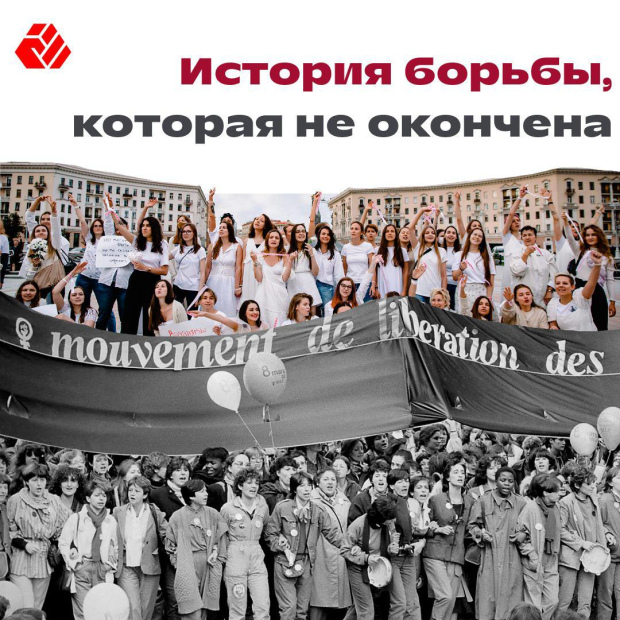International Women's Day, celebrated on March 8, has a long and interesting history. This holiday, which today is associated with flowers, gifts and congratulations, should actually remind us of the struggle with which it began. Including the fight with flowers in the hands of Belarusian women, which is not over either for us or for the world.
Let's remember why women walked down Broadway in the last century. And let us remember our Belarusian women who fought and continue to fight.
1908: Protest on Broadway.
At the beginning of the 20th century, women in different countries began to actively fight for their rights. They demanded equal opportunity, voting rights, better working conditions and education.
What did women face?
Long working days:
Terrible working conditions:
In this context, an important event was the Women's March on Broadway in New York on March 8, 1908. Women dressed in rags marched down Broadway demanding justice. They held signs saying “Enough!”, “Bread and roses!”, “Vote for women”, “Shorten the working day” and “Ban child labour”.
More than 15 thousand women came out not only to Broadway, but also to other streets of New York. The organizer of the march was Maud Malone, a radical suffragist, president of the Harlem Equal Rights League and founder of the Progressive Women's Union.
The march on Broadway attracted public attention. This was a bold move in a time when women rarely challenged their fate. Already in 1910, New York City established a 9-hour working day for women. And in 1920, US women received the right to vote. The 1908 protest was one of the first links in the chain that led to International Women's Day. Women of Belarus and women of the world, the fight is not over.
Women know how to fight. The Belarusian protest was proclaimed throughout the world as a women’s protest. Remember the red cover of the Guardian, with the Belarusian woman holding a flower in her hand and the headline “Flower Power”?
.png)
It was the women's march that became decisive in the protests of 2020. Thousands of women dressed in white, holding flowers, took to the streets of Minsk. They demanded that their voices be returned not only to them, but also to men. And they became a symbol of the struggle not only for their rights, but for the freedom of the country. And these marches with flowers in their hands influenced the fact that the revolution in Belarus was called a women's revolution.
On March 8, on the day of flowers and struggle, let's remember not only women's rights, but also the rights of Belarusian women political prisoners who are today in regime prisons. Our fight continues.
The tyrant stubbornly holds power, but protest inspired and led by women is the seed that is sure to sprout. The main thing is to remember that the fight is not over. Neither our struggle nor the struggle of women for full equality.
Let's remember why women walked down Broadway in the last century. And let us remember our Belarusian women who fought and continue to fight.
1908: Protest on Broadway.
At the beginning of the 20th century, women in different countries began to actively fight for their rights. They demanded equal opportunity, voting rights, better working conditions and education.
What did women face?
Long working days:
- Working days for women were excessively long. They often worked 10-14 hours a day.
- Women received meager wages, significantly less than men.
Terrible working conditions:
- Factories and workshops were places where women faced poor and even dangerous working conditions.
In this context, an important event was the Women's March on Broadway in New York on March 8, 1908. Women dressed in rags marched down Broadway demanding justice. They held signs saying “Enough!”, “Bread and roses!”, “Vote for women”, “Shorten the working day” and “Ban child labour”.
More than 15 thousand women came out not only to Broadway, but also to other streets of New York. The organizer of the march was Maud Malone, a radical suffragist, president of the Harlem Equal Rights League and founder of the Progressive Women's Union.
The march on Broadway attracted public attention. This was a bold move in a time when women rarely challenged their fate. Already in 1910, New York City established a 9-hour working day for women. And in 1920, US women received the right to vote. The 1908 protest was one of the first links in the chain that led to International Women's Day. Women of Belarus and women of the world, the fight is not over.
Women know how to fight. The Belarusian protest was proclaimed throughout the world as a women’s protest. Remember the red cover of the Guardian, with the Belarusian woman holding a flower in her hand and the headline “Flower Power”?
.png)
It was the women's march that became decisive in the protests of 2020. Thousands of women dressed in white, holding flowers, took to the streets of Minsk. They demanded that their voices be returned not only to them, but also to men. And they became a symbol of the struggle not only for their rights, but for the freedom of the country. And these marches with flowers in their hands influenced the fact that the revolution in Belarus was called a women's revolution.
On March 8, on the day of flowers and struggle, let's remember not only women's rights, but also the rights of Belarusian women political prisoners who are today in regime prisons. Our fight continues.
The tyrant stubbornly holds power, but protest inspired and led by women is the seed that is sure to sprout. The main thing is to remember that the fight is not over. Neither our struggle nor the struggle of women for full equality.


 Continue
Continue
